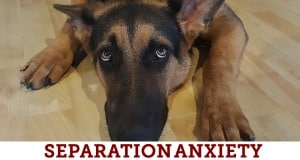
Tulsa SPCA Names Veterinary Clinic in Honor of John R. and Tricia Arend
April 26, 2021
Fireworks Are Scary for Pets
July 1, 2021
Destroyed doorways and kennels, neighbors complaining about constant barking, and having to clean up potty messes in the house as soon as you get home will tear away at even the best human-canine relationships. What we are talking about is separation anxiety; dogs who go into panic mode when their owners leave. It is important to note a true diagnosis of separation anxiety is a medical diagnosis and must be made by a veterinarian.
Separation anxiety is a misunderstood disorder, and it is prudent to first rule out easy to solve issues such as a lack of potty training, chew training, or crate training. Many dogs will panic if suddenly left in a crate for multiple hours without proper, positive conditioning to a crate first. Many dogs will also potty inside and destroy things while we are gone if they have not been completely potty trained (and are at an age where they can realistically hold it for as long as we’re gone) or chew trained yet. The first step in ruling out these issues is to get eyes on the scene, even when you’re not there. There are many low-cost camera options available. Dogs who lack training look happy and calm as they move about the home chewing on Roku remotes and chair legs or urinating on rugs. Dogs with separation anxiety looks tense and alert, often whining, howling, pacing, panting, drooling, and destroying things near the exit door.
Once a simple lack of training has been ruled out, you’ll want to contact both your veterinarian and a qualified separation anxiety trainer. There are many supplements and medications your vet can prescribe to help set your dog up for success. A dog trainer can assist you with the work of desensitizing your dog to absences, as it is a gradual and complex process. Luckily, all the coaching work can be done remotely which allows you several options for trainers. You can find trainers who have been educated to perform separation anxiety training in humane ways through these organizations:
If hiring a qualified trainer is out of your budget, there are a few self-paced resources you can access:
- https://malenademartini.com/for-owners/separation-anxiety-in-dogs-mission-possible-online-course/
- Don’t Leave Me! Step-by-Step Help for Your Dog’s Separation Anxiety, by Nicole Wilde
- Separation Anxiety in Dogs: Next Generation Treatment Protocols and Practices, by Malena DeMartini-Price
- I’ll Be Home Soon! How to Prevent and Treat Separation Anxiety, by Patricia McConnell
Unfortunately, there is a lot of misinformation about separation anxiety. Let’s debunk some of the myths now:
- Put an anti-bark collar on your dog. Dogs who cry and whine when distressed are simply trying to communicate. Punishing that does nothing to change their emotional state for the better and will most likely make them feel even worse than they already do.
- Crate the dog. Crates are not the answer for dogs with true separation anxiety. Tight confinement often makes anxiety worse, and while industrial strength crates might save our furniture and carpet, it does nothing to change the emotions your dog has around being left alone. Leaving dogs to panic in crates for hours is not a humane solution to separation anxiety.
- Give the dog a Kong. Most of the time using food for training is the way to go, but that isn’t the case with separation anxiety. If the dog is simply fussy for the first few minutes of their alone time then a stuffed Kong toy might be the perfect solution, but for dogs with true separation anxiety, food is just a momentary distraction and does nothing to teach them to be comfortable during alone time.
- Get another dog! If your dog is simply bored getting him a compatible friend might be great, but dogs with true separation anxiety are most often not helped by additional animals being in the home.
Finally, it’s completely normal for dogs to not enjoy being left alone when recently adopted. Dogs are social creatures and being in a new environment is already stressful. When adopting, plan to have a few days post adoption where you don’t need to leave the home for long periods. During these days work on getting your new family member comfortable with your absence and slowly working up to longer durations.
Angela Rodriguez owns The Joyful Hound, a dog walking and training business in midtown Tulsa. When she is not taking care of people’s pets she is working at the Tulsa SPCA as their Training and Assessment Specialist. There she uses her education and skills to set shelter dogs up for success in loving homes.

